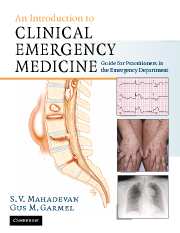Book contents
- Frontmatter
- Contents
- List of contributors
- Foreword
- Acknowledgments
- Dedication
- Section 1 Principles of Emergency Medicine
- Section 2 Primary Complaints
- 9 Abdominal pain
- 10 Abnormal behavior
- 11 Allergic reactions and anaphylactic syndromes
- 12 Altered mental status
- 13 Chest pain
- 14 Constipation
- 15 Crying and irritability
- 16 Diabetes-related emergencies
- 17 Diarrhea
- 18 Dizziness and vertigo
- 19 Ear pain, nosebleed and throat pain (ENT)
- 20 Extremity trauma
- 21 Eye pain, redness and visual loss
- 22 Fever in adults
- 23 Fever in children
- 24 Gastrointestinal bleeding
- 25 Headache
- 26 Hypertensive urgencies and emergencies
- 27 Joint pain
- 28 Low back pain
- 29 Pelvic pain
- 30 Rash
- 31 Scrotal pain
- 32 Seizures
- 33 Shortness of breath in adults
- 34 Shortness of breath in children
- 35 Syncope
- 36 Toxicologic emergencies
- 37 Urinary-related complaints
- 38 Vaginal bleeding
- 39 Vomiting
- 40 Weakness
- Section 3 Unique Issues in Emergency Medicine
- Section 4 Appendices
- Index
36 - Toxicologic emergencies
Published online by Cambridge University Press: 27 October 2009
- Frontmatter
- Contents
- List of contributors
- Foreword
- Acknowledgments
- Dedication
- Section 1 Principles of Emergency Medicine
- Section 2 Primary Complaints
- 9 Abdominal pain
- 10 Abnormal behavior
- 11 Allergic reactions and anaphylactic syndromes
- 12 Altered mental status
- 13 Chest pain
- 14 Constipation
- 15 Crying and irritability
- 16 Diabetes-related emergencies
- 17 Diarrhea
- 18 Dizziness and vertigo
- 19 Ear pain, nosebleed and throat pain (ENT)
- 20 Extremity trauma
- 21 Eye pain, redness and visual loss
- 22 Fever in adults
- 23 Fever in children
- 24 Gastrointestinal bleeding
- 25 Headache
- 26 Hypertensive urgencies and emergencies
- 27 Joint pain
- 28 Low back pain
- 29 Pelvic pain
- 30 Rash
- 31 Scrotal pain
- 32 Seizures
- 33 Shortness of breath in adults
- 34 Shortness of breath in children
- 35 Syncope
- 36 Toxicologic emergencies
- 37 Urinary-related complaints
- 38 Vaginal bleeding
- 39 Vomiting
- 40 Weakness
- Section 3 Unique Issues in Emergency Medicine
- Section 4 Appendices
- Index
Summary
Scope of the problem
The American Academy of Poison Control Centers (AAPCC) reports over 2 million toxic exposures each year across the US. The demographics of human poisoning show two peaks of exposure. The first peak is in children from 1 to 3 years of age reflecting accidental ingestions. The second peak is in the elderly due to the increased risk of toxicity from multiple prescription drugs. Intentional overdose for abuse or suicidal intent is seen throughout the adolescent and adult populations.
The most common exposures are cleaning agents and over-the-counter analgesics (acetaminophen (APAP), ibuprofen, etc.). The agents responsible for the most fatalities are analgesics, antidepressants, cardiovascular agents, and drugs of abuse. Carbon monoxide (CO) and drugs of abuse are responsible for many deaths that are never reported to a poison control center (PCC). Data show that analgesics, antidepressants, and cardiovascular agents are also associated with significant morbidity and mortality.
Most patients who are poisoned will recover with supportive care alone. However, some may require specific antidotes or other therapeutics under the guidance of a regional PCC or medical toxicologist. The identification and treatment of poisoning emergencies is part of the unique and specialized knowledge of emergency medicine physicians and medical toxicologists. Emergency physicians are on the front line of caring for these patients and must be familiar with the principles of common poisoning diagnosis and management.
Pathophysiology
There are three basic physiologic concepts required to understand the effects of toxic agents on the human body: absorption, distribution, and elimination.
- Type
- Chapter
- Information
- An Introduction to Clinical Emergency MedicineGuide for Practitioners in the Emergency Department, pp. 531 - 542Publisher: Cambridge University PressPrint publication year: 2005



